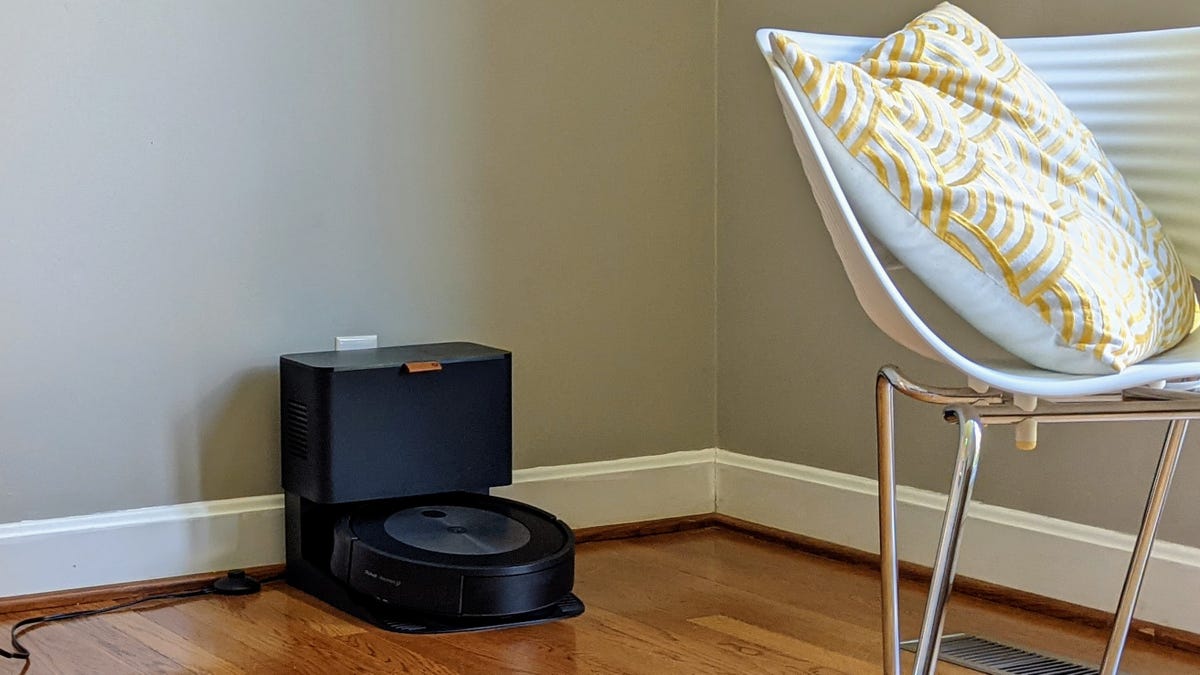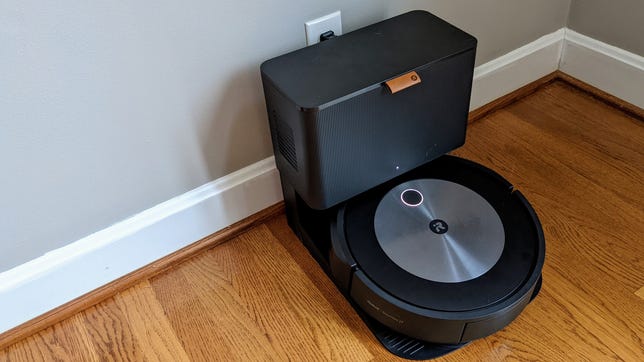 Why You Can Trust CNET
Why You Can Trust CNET Review: Roomba J7 Plus solves the No. 1 robot vacuum problem
The iRobot Roomba J7 Plus detects pet poo and other traps to sidestep sticky situations.
Robot vacuums are convenient, but almost all models I've used share a common weakness: They sometimes get stuck. The cause may be something as simple as a stray sock or pile of clothes. Power strips, home wiring and headphones are other problematic items of clutter.
The new $700 iRobot Roomba J7 Plus is designed to be different. According to iRobot, the J7 is smart enough to identify potential pitfalls as it cleans. The company even claims the machine will avoid pet poop, the featured substance in a number of viral robot vacuum-fail videos. I'm happy to say that the Roomba J7 Plus lives up to the hype in its ability to navigate a space and avoid obstacles. It's the smartest robot vacuum I've ever tested.
I can't put the Roomba J7 Plus on the same pedestal with regard to its cleaning power, though, as it doesn't clean quite as well as its more expensive predecessor, the $1,100 Roomba S9 Plus. A competitor's bot, the $650 Roborock S7 also delivered better cleaning results. The Roborock model can't empty its own dustbin like the J7 Plus, but it has a mopping function, something no Roomba can tackle by itself.
Still, the Roomba J7 Plus is perfect if you like to vacuum and not have to stick around to babysit your robot. The same is true if you're a pet owner who dreads a potential "poopocalypse."
Like
- Recognizes objects it should steer clear of, even pet poop
- Automatically suggests areas you may want to avoid
- Self-emptying dustbin
- Attractive design
Don't like
- Has less cleaning power than other robots
- It's expensive
Product details
- Battery Life/Runtime 100 min
- Weight 7.49 lb
- Bin Capacity 0.1 gal
- Anti-Allergy Filter (HEPA) No
- Vacuum Type Robot
A bit more style
The Roomba J7 Plus is a handsome product. The robot's body is crafted from solid-feeling black plastic with silver highlights. Color shifting LED indicators swirl around the vacuum's "clean" button in either white, blue or red. Unlike the S9 Plus' gigantic base, the J7's "L" shaped charging dock is more compact, too.
There's a faux leather tab on the base lid for an extra dose of style.
To enhance the machine's premium looks, iRobot also added a faux leather tab to the dock's lid. Lifting it upward reveals two dust disposal bags, one for storage on the left and the other for active use on the right. The dock (iRobot calls it the Clean Base) automatically suctions out to the robot's dustbin when needed. iRobot says each bag can hold up to 60 days of dirt and debris.
The Roomba J7 Plus navigated our test room with speed and logical movement.
Performance in the lab
While in our robot vacuum test lab, the Roomba J7's performance was a mix of excellence and mediocrity. For instance, the machine speedily navigated our test room. It needed just 17 minutes to complete the task. It's the third fastest time we've seen, right behind the Ecovacs N8 Plus (14 minutes) and Roborock S7 (15 minutes). By comparison, the Roomba S9 took an average of 25 minutes.
That said, the S9 Plus and Roborock S7 also demonstrated better cleaning power. Each removed more sand than the J7 could across all three of our test surfaces (hardwood, low-pile carpet, medium-pile carpet). The J7's performance on medium-pile carpet was the most dismal. The robot removed an average of just 17% of sand from this surface type -- the lowest percentage we've logged yet.
The iRobot Roomba J7 Plus was able to consistently avoid our fake dog poop.
However, one test where the J7 Plus delivered was its solid pet waste avoidance. Full disclosure: We didn't use actual pet waste here. Instead, we used prank dog poop in three different shapes to represent the noxious stuff. Inside of a closed pen, the J7 easily cleaned open areas around our fake waste. That level of restraint was consistent, too -- it didn't touch any prank poop across multiple test runs.
The Samsung Jet Bot AI Plus consistently failed our solid pet waste test. It would eventually run over or push our (prank) dog poop.
That's not the case with the Samsung Jet AI Plus, another robot billed to avoid solid pet waste. That machine did the opposite, consistently running into at least one of our fake poop piles per run.
Cleaning in the real world
After using the Roomba J7 Plus in a real home, one fact became clear: This is a very intelligent machine.
First, I mapped out a floor plan, a process that can take over an hour depending on the size of your abode. Next, I labeled each room within the iRobot app and fine-tuned the dividing lines between them.
The iRobot app displayed areas that the Roomba J7 flagged as possibly problematic.
With that done, I began to run multiple cleaning sessions. The first few went for close to 2 hours (1:44), or just over that (2:13), before failing. Each time, the robot had trouble finding its dock. After the second run, the app presented images of areas the robot's camera considered potential obstacles. Within the app I could then designate each area as temporary, or flag it as a "Keep Out Zone" or not an issue. Once you tag these areas, the app will program the robot accordingly.
The Roomba detected Keep Out Zones automatically and also relied on user feedback.
After the J7 finished "learning" my instructions, it ran for a full 3 hours and 8 minutes. During this time it docked twice (once to charge midsession) without a hitch.
The Roomba J7 Plus then "learns" to navigate better based on your input.
It's an impressive feature. The J7 is the only vacuum I know of that offers this level of intuitive obstacle-avoidance. Ecovacs Deebots come close, but they typically suggest areas you ought to declutter, not ones you might want the machine to seamlessly avoid.
This is a work in progress, too. iRobot told me that plans for the robot to recognize other threats are in the works. For example, it'll soon be able to avoid shoes and socks just as well as pet waste, iRobot said.
The verdict
Robot vacuums are neat time-saving devices, at least in theory. In my experience, all models at some point run into problems under real-world conditions. It could be the odd toy, cord or worse -- pet waste -- that shuts down a machine. iRobot's J7 Plus aggressively tries to solve this dilemma. It's also the most successful product of its kind to do so.
That makes the J7 Plus a great fit if you generally have a hectic or cluttered living situation. The same goes if you're a pet owner who fears a disastrous meeting of poop and robot. If you want the most cleaning power though, you'll be better served by the $1,100 Roomba S9 Plus. It's expensive but removes more dirt across multiple surfaces.
The $650 Roborock S7 is also better at vacuuming floors than the J7 Plus, and its mopping abilities set it apart, as well. So choose the S7 if you want shining floors as part of the deal.



